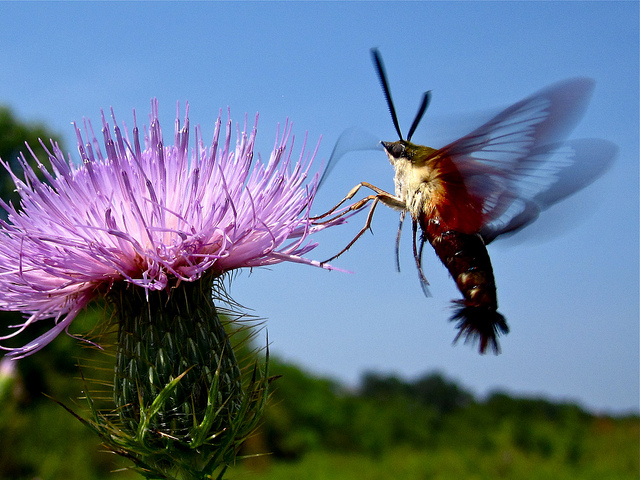Nectar plant preferences of Hemaris (Sphingidae) on co-occurring native Cirsium and non-native Centaurea (Asteraceae) inflorescences
DOI:
https://doi.org/10.26786/1920-7603(2014)16Abstract
Preferences for certain nectar plants by moth pollinators have not been extensively studied, particularly seasonal switches in nectar diet. The genus Hemaris, found throughout North America and parts of other continents, is a useful new system to address questions of flower-insect interactions as the moths are relatively common and day-flying. In this study we address the following questions with a group of three Hemaris species. (1) Does Hemaris display a preference for foraging on the native swamp thistle, Cirsium discolor, over the non-native invasive knapweeds, Centaurea spp.? (2) What factors might be driving Hemaris’ preferences? The bloom periods of C. discolor and Centaurea overlap in the northeastern United States, with Centaurea blooming from approximately June through September and C. discolor blooming for approximately the first three weeks of August. Hemaris typically ecloses in the first week of July and fed on Centaurea until C. discolor bloomed. We tracked and recorded Hemaris visits to both plant species. During the co-blooming period of C. discolor and Centaurea, Hemaris visits significantly more C. discolor inflorescences, demonstrating a possible preference for the native species. Hemaris reverts to nectaring at the non-native Centaurea after native C. discolor’s bloom period ends. The nectar of C. discolor has a significantly higher sugar concentration than does the nectar of Centaurea; this difference may account for part of the moths’ preference for C. discolor.

Downloads
Published
How to Cite
Issue
Section
License
Copyright (c) 2014 Elena S. Tartaglia, Steven N. Handel

This work is licensed under a Creative Commons Attribution 4.0 International License.
JPE is an open access journal which means that all content is freely available without charge to the user or his/her institution.
Authors who publish with this journal agree to the following terms:
1) Authors retain copyright and grant the journal right of first publication with the work simultaneously licensed under a Creative Commons Attribution License that allows others to share the work with an acknowledgement of the work's authorship and initial publication in this journal.
2) Authors are able to enter into separate, additional contractual arrangements for the non-exclusive distribution of the journal's published version of the work (e.g., post it to an institutional repository or publish it in a book), with an acknowledgement of its initial publication in this journal.
3) Authors are permitted and encouraged to post their work online (e.g., in institutional repositories or on their website) prior to and during the submission process, as it can lead to productive exchanges, as well as earlier and greater citation of published work (See The Effect of Open Access).
To assure a broader targeted audience, content will be included into databases (such as EBSCO) and directories (such as DOAJ).











